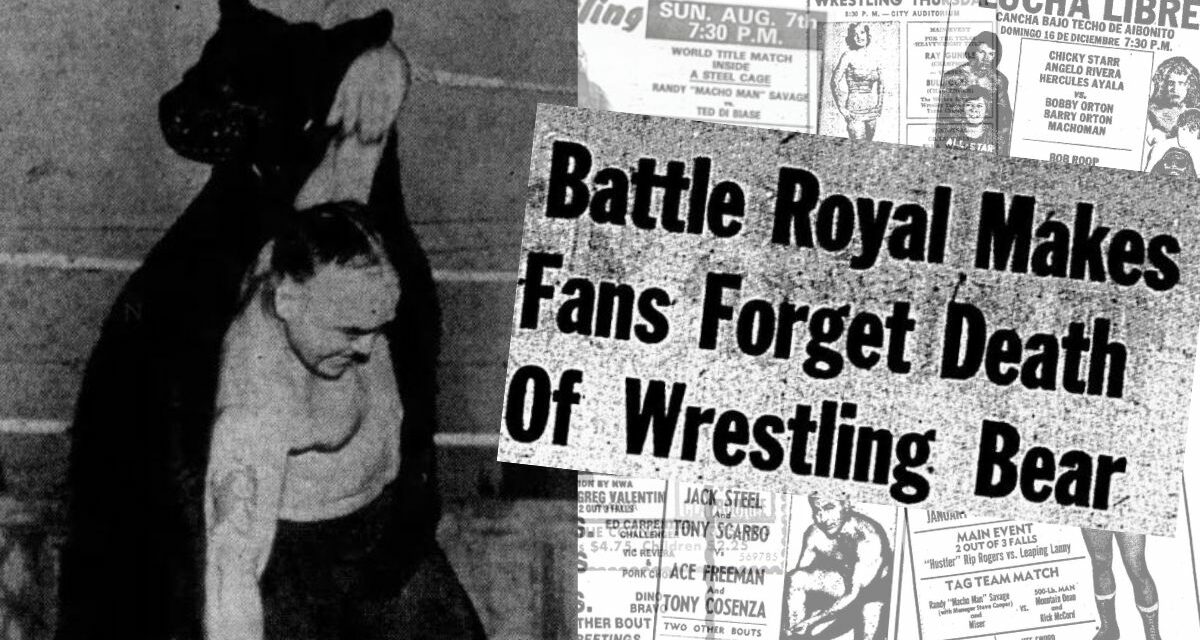In southern Ontario, July 4th is always a day of reflection, as it marks the anniversary of the death of “Bearman” Dave McKigney, Adrian Adonis, and Pat Kelly in an accident in Newfoundland and Labrador. The Bearman had color and charisma to spare and is rightfully celebrated as one of Canada’s greatest-ever characters, tragedy, and triumph included.
But what about July 7th? There’s a bear connection that day, too, for Ontario.
That is the day that Ginger the Wrestling Bear died unexpectedly hours before her bout in Barrie, Ontario, at the local TV studio.
The year was 1958.
Pat Malone was Ginger’s keeper, and the duo was on tour in Ontario, with many dates for Larry Kasaboski’s Northland Wrestling Enterprises, which ran only during the summer when the hockey rinks had no ice — conveniently when bears are not hibernating.
There was a bout set for Tuesday, July 8, 1958, at the Barrie Arena, which hosted weekly cards. It was going to be Bill Curry, pride of North Bay, against Ginger.
Naturally, wanting to drum up interest, Malone had arranged for Ginger to go to the local TV station. The Barrie Examiner picks up the story:
Early last evening, Ginger was scheduled to make an appearance on CKVR-TV. While waiting for her cue, the playful animal romped around inside the studio.
At practically the same instant the sportscaster gave the cue for her to appear, the bear dropped dead. Doctors said it was felled by a heart attack.
A newswire report of the death added more details, just a minute before going live: “Sportscaster Bill Bennett, told of the bear’s death as the program went on the air, quickly explained to his audience the interview had been cancelled and ad-libbed a few sports items to fill the program.”
Kasaboski and crew scrambled to remake the card, and remarkably, Malone worked in the battle royal to start the show.
“It wasn’t until the first bout as scheduled to get underway that a good many of the spectators first heard the news that Ginger had died of a heart attack only a couple of hours earlier,” reported the Examiner. “Only two persons returned to the wicket for refunds.”
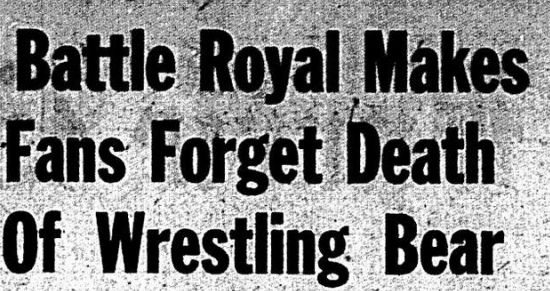
As sad as the story is, it didn’t stop Malone, who spent at least 60 years in the wrestling business, including wrestling under a mask as The Green Shadow. He had many bears after Ginger … all named Ginger.
A Wrestling News story from its October/November 1977 edition described Malone and his bears: “He was respected by all who knew him for the excellent treatment the bears always received from him. The man against bear matches were athletic contests. He took safety precautions always when sending one of his bears into the ring against a man. Muzzles were always secured to the mouths and the claws were always filed down on the front paws. And he insisted the opponent wrestle the bear and did not ever stand for any abuse.”
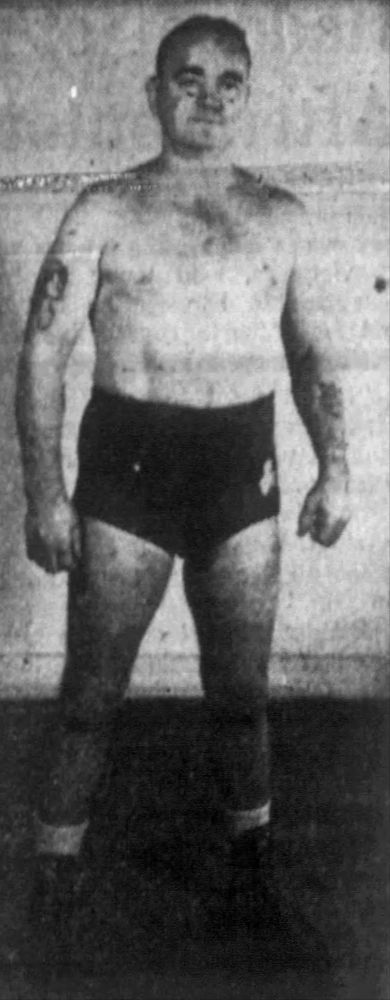
Pat Malone
Malone’s history in pro wrestling is only enhanced by his end-of-career tie-in to bears. Born Edgar Bryan Davie in Illinois, on August 25, 1900, he first started appearing on cards in 1923 as Joe Malone. But WrestlingData.com lists many names for him: Black Bat, Eddie Malone, Edgar Davie, Ed Malone, Edward Malone, Green Ghost, Green Shadow (1944-50 or so), Jock Malone, Mr. X (unmasked in 1950), Pat Davie, Pat O’Brien, Purple Flash. At times he was “The Illinois Terror” Pat Malone. As for the name Pat Malone itself, two theories: a) There was a well-known baseball player named Perce “Pat” Malone, who pitched in the majors from 1928-37; b) There was a popular Irish drinking song “Pat Malone The Man Who Forgot He Was Dead.”
One last note:. Perhaps he took his name from the song.
When Malone returned to Knoxville, Tennessee, in November 1952, the newspaper recalled his alter-ego: “For several years, the [Green] Shadow, nee Pat Malone, was the biggest drawing card on the southern circuit. An exceptionally rough performer, he also possessed considerable science and his non de guerre on the card always insured a capacity turnout.” (Apparently, playing up the Malone/Irish connection, he saw upon unmasking that his roots were in Boston, not Illinois.)
“A serious automobile accident with resulting ill health forced Pat out of the wrestling ring after 20 years of grunting and groaning,” wrote George Nuttall in the Miami News in December 1947. “He headed south for the year ’round sunshine and set up business as a promoter in 1945.” (No mention of an apparent family row in Miami where he was stabbed twice in the abdomen by his father-in-law in 1946, and his wife was also slashed up.)
In the Nuttall piece, he also playfully talked about Malone’s relationship with Ginger, and their win-loss record.
Ginger had pide up an enviable string of victories until Pat found her weakness. She couldn’t wrestle unless she had a large audience. The roar of the crowd made her angry and she wouldn’t be floored, but alone, Pat says, he beat her every time. But alas, no one was there to put it in the record books.
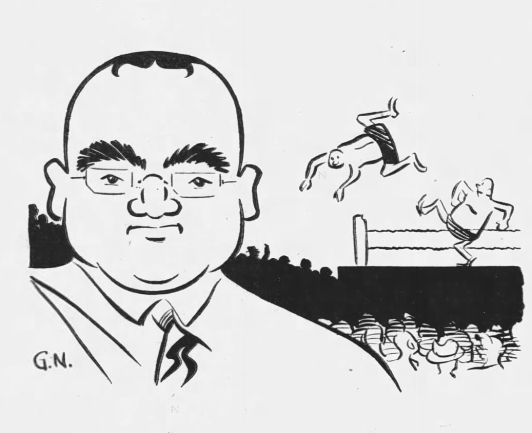
A drawing of Pat Malone that accompanied George Nuttall’s piece on him in the Miami News.
Malone, based out of southern Florida, befriended the Welch family, which promoted in what we now call the Gulf Coast territory at the northern end of the Sunshine State.
The first Ginger bear, a female, appears in the mid-1940s, apparently owned by Lester and Roy Welch. She worked for roughly five years, wrestling challengers and even apparently in battle royal matches.
The second Ginger was the son of the first Ginger and weighed 310 pounds, and was 6-foot on hind feet when he started wrestling, and that’s the bear Malone started training in the fall of 1948.
By 1957, Malone was busy training Ginger III in Nashville. The local newspaper, the Banner, reported that this Canadian black bear cost Malone $150 and that he shared his 8′ x 12′ pen with a six-month-old bulldog named Frisky.
“Bears may look and appear dumb and clumsy,” Malone told writer Red O’Donnell, “but actually they are intelligent — more so than dogs, because bears don’t forget.”
Training takes time, added Malone. “Bears are not good as wrestlers until they are five years old.”
Though difficult to confirm, this Ginger III is likely the bear that died in July 1958. There’s a reference to “Ginger Sr.” dying “about two years ago” in January 1958.
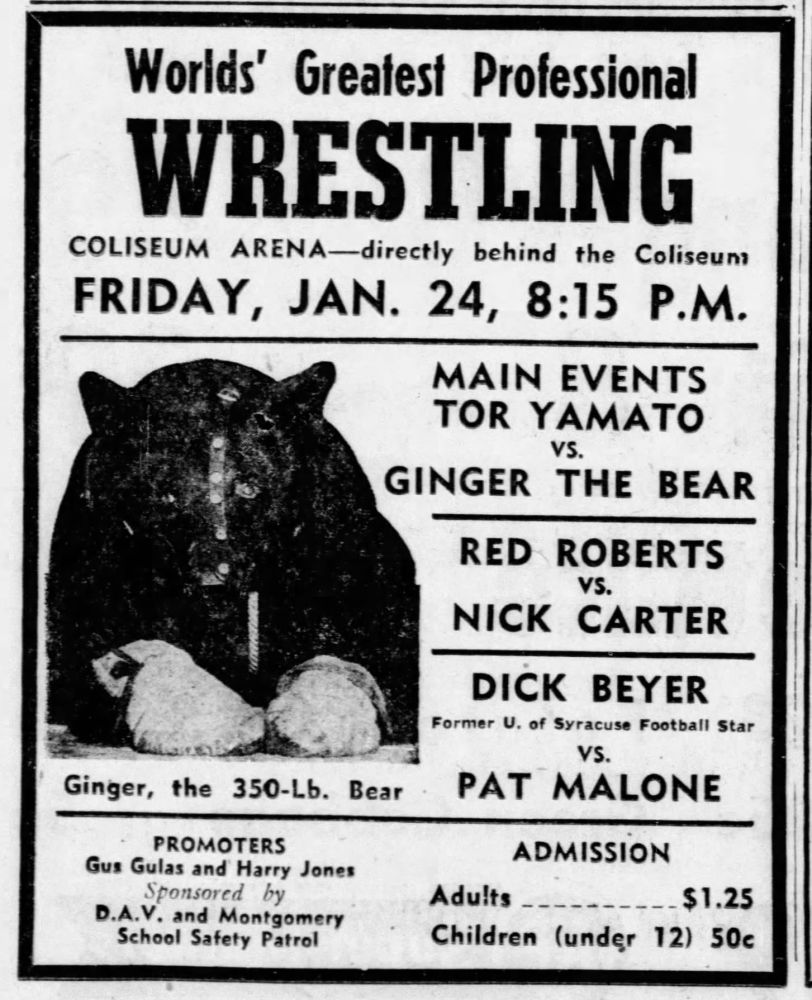
Ginger and Pat Malone on a card in Montgomery, Alabama, on January 24, 1958.
Ted Ayerst, the Toronto newsman who spun tales for Frank Tunney’s wrestling office in the Globe & Mail, told another macabre tale in 1958:
Another bear, Ginger, used to wrestle in the U.S. a few years ago. Finally, while being hauled by trailer on a long trip across desert land, Ginger died. The wrestlers accompanying him had barbecued bear steaks that night under the stars.
They were enjoying it, too, until someone remarked:
“This is kinda sad,” he mused. “It’s just like eating one of the boys.”
Another Ginger died in 1977, its death the reason for the Wrestling News piece by Pat Langer:
Ironically, Ginger’s death was not the result of a wrestling injury or illness. Malone feels that it was a direct result of a state law passed to prevent black-marketing of bears. A wildlife officer and a veterinarian paid Malone a visit a few weeks ago. They came to tattoo an identifying number in Ginger’s ear that was required by the law. To do this they insisted they give the bear what they thought was the right dose of an animal sedative. “The bear immediately went into convulsions for six hours and then died,” Pat told us. Malone feels that the bear was given an overdose.
The death of Ginger haunts Pat Malone. “I think about feeding the bear before I shower and shave each morning. That bear ate better than a lot of humans. I made sure that she lived better than a lot of people. Sometimes I wake up in the morning and I can just see that bear going into convulsions,” he said sorrowfully.
There were, of course, countless other wrestling bears. Tuffy Truesdale took one around (separate from his touring alligator), Victor the Wrestling Bear was out on the west coast. McKigney went through three bears. There were Gentleman Ben, Sonny, Toby, Sampson …
There were, of course, countless attempts by animal activists and politicians to curb bear wrestling.
What does it take to train a bear to wrestle? Malone shared the story.
In February 1949, Malone told Guy Butler of the Miami Daily News about the work in progress of schooling the new Ginger (the second one probably). “I’ve been up in Tennessee — Dyersburg — helping to train a bear to wrestler. And I’ll be bringing him in soon. His name is Ginger. He weighs 200. We keep him in a cage 36 inches high. But when he stands up on his hind legs he’s taller than I am, and I’m 5-feet-11.”
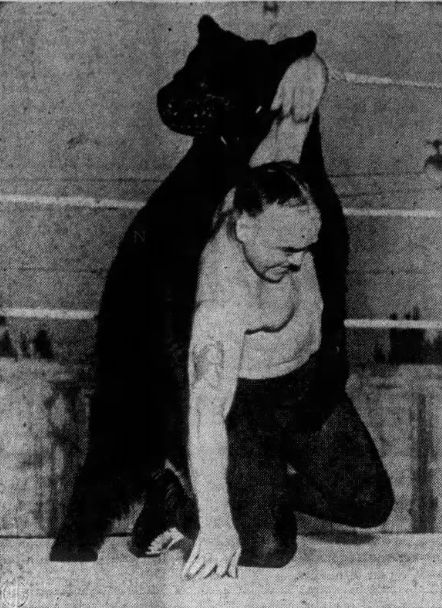
Pat Malone grapples the second Ginger the bear in a widely circulated promotional photo.
On the outside, just after the wild black bear was caught, it was put in a cage, muzzled, and they put the ursine to sleep so the claws could be removed and the teeth filed down. “A bear’s teeth are built into the jawbone, unlike a human being’s, and you can’t pull them,” said Malone. “Well, the first thing a bear wants to do to you is hug or squeeze you, and this one did too. But we’ve got him doing other things now — oh, yes, that includes biting you with his stubs if the muzzle isn’t on him. And just look at these marks on me.”
Malone further laid out Ginger’s grappling lessons:
Several of us have been teaching him tricks of the mat. He won’t let a man get behind him now. When he’s on the mat and you get up he doesn’t rise immediately, but waits until you start for him, then he gets up in a hurry and is ready for you.
We’ve been sticking a leg out at him and are about to teach him to leg-dive.
If he gets on top of you he’ll pin you. He presses all his weight on you and then with his big hairy paws he grabs your hands and holds you down, flat of your back.
Malone stressed that Ginger was by no means tame. “He raises the very devil and is always wanting to bite or try to claw, but of course, he doesn’t do either so well anymore. After he gave me a rough session recently, I decided I was going to get even with him, bite a chunk out of his ear. I bit him. but no chunk out. And did he roar? It was the first time we’d ever really got a good long bellow out of him. Well. it so pained him he wound up and slapped me right in the eye with his big paw. It knocked me down and gave me a shiner.”
Foes were warned to never hit Ginger’s nose, as that would result in a devastating paw wallop. You could get on Ginger’s good side, though, with orange pop or honey.
There were few places that Malone (who apparently stopped promoting in Miami circa 1949, when Cowboy Luttrall took over much of Florida) and Ginger didn’t go, with matches across the United States, Canada, and even down to Cuba. He fell off the wrestling circuit for the most part after 1958, and he apparently worked in the Gulas – Welch Wrestling out of Nashville as the travel secretary, helping arrange for wrestlers coming and going. His son, also named Eddie, wrestled as Eddie Davie and Eddie Davis.
The senior Malone died on March 15, 1988.
Back to Barrie, though, and proof that the show must go on. “Arena manager Wes Allsopp was quite disturbed about the death of the last bear that was to appear here and has gone to considerable expense to bring in Brownie. He knows full well the kiddies will love it,” reported the Examiner. That bear’s foe? Once again, Bill Curry.
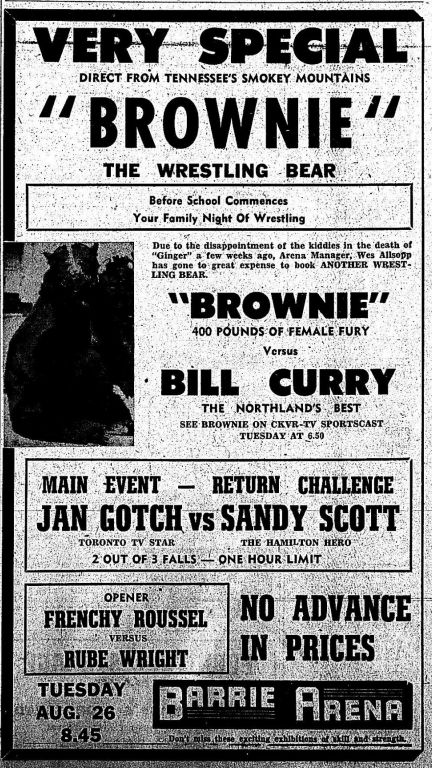
— with files from Mark Hewitt
